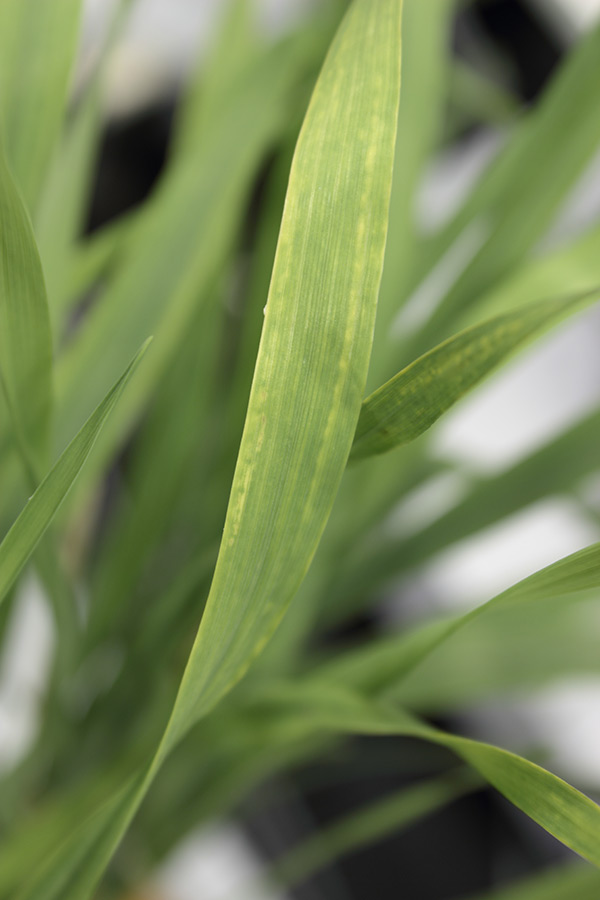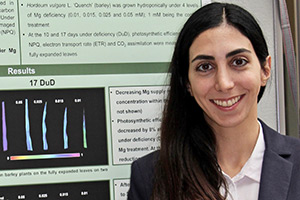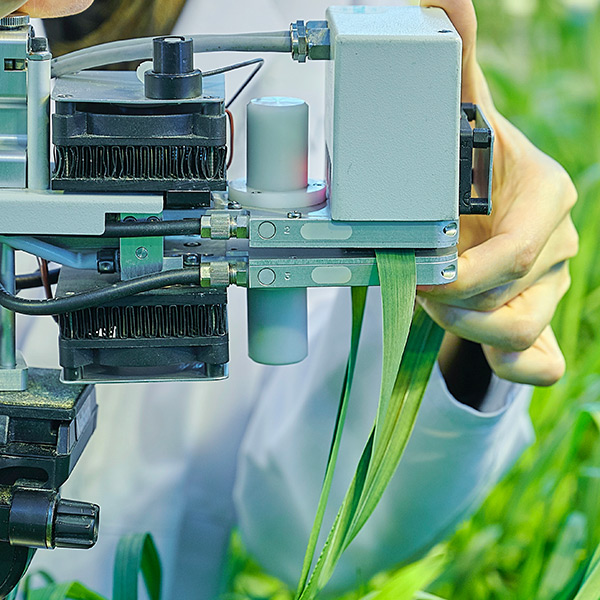Research
In this research project, the aim was to quantify the effect of magnesium (Mg) supply on biomass and photosynthetic performance of various plant species.
The idea was to collect and combine data of all relevant existing scientific literature about Mg and plant growth of the last 70 years in a systematic literature study to calculate critical leaf Mg concentrations for crop growth. Therefore, an intensive search strategy using the online data bases Web of Science and Google Scholar was conducted.
We gathered all literature that focused on the relation between Mg nutrition, tissue Mg concentrations and the parameters biomass, yield, net carbon dioxide (CO2) assimilation, reactive oxygen species (ROS) as well as activities of enzymes and metabolites involved in scavenging ROS.
We found more than 200 studies related to our research questions. Nearly half of them provided enough information to be further statistically examined. We extracted the data and combined them in a meta-analysis to calculate the overall effect of Mg and to further find relationships between leaf Mg concentrations and parameters that can be related to plant growth and photosynthesis.
Our research questions were the following:
- How is the effect of Mg supply on biomass formation, photosynthetic CO2 assimilation and anti-oxidative enzyme activities?
- What factors influence the magnitude of these Mg responses?
- What leaf Mg concentrations are critical for growth and photosynthesis?
Mg and biomass production
Mg is an important element for plant production. However, for a long time, it seemed to be neglected by agronomists and researches because plant production appeared to be primary limited by nitrogen (N), phosphorus (P) and potassium (K). This is reflected by the number of publications used in this study: from 1960 to 2009, 45 relevant studies about Mg in plant nutrition were published whereas 61 studies were published within the last years, from 2010 to 2018.
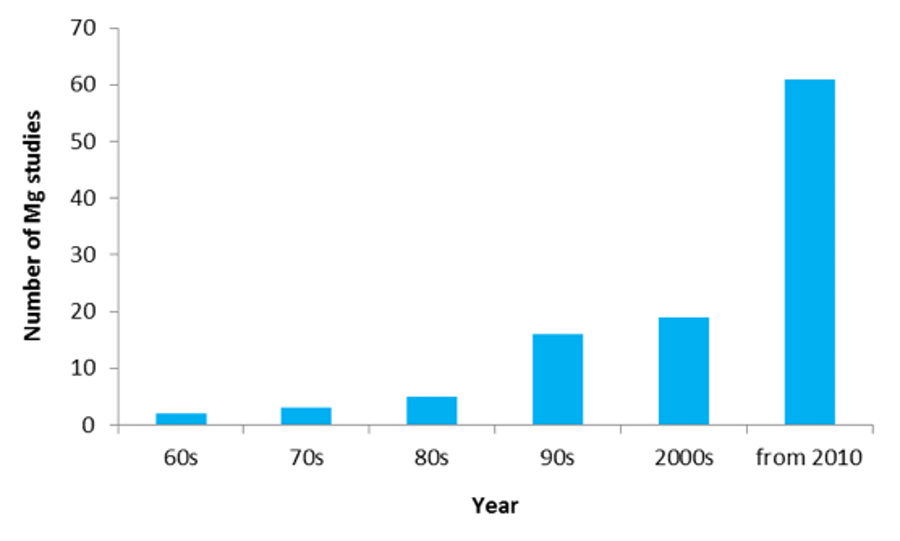
Number of magnesium studies published during the last decades and used in the meta-analysis study. (Source: Tränkner)
In our study, we found that biomass, i.e., dry matter of the whole plant, can be significantly improved due to an adequate Mg supply compared to plants deficient in Mg. The effect of Mg on biomass of roots is even more pronounced than the effect on shoots.
Mg is important for many physiological and biochemical processes in the plant. For example, under Mg deficiency, carbohydrates produced in source leaves were found to accumulate and translocation to growing plant parts such as roots was inhibited. A decrease in root biomass compared to shoots and thus, an increased shoot-root ratio was often observed and described as one of the first symptoms under Mg deficiency. During our analyses, we found that there are also a considerable number of reports, where shoot-root ratios were not affected by Mg or even decreased under Mg deficiency. Our meta-analysis revealed that shoot-root ratios are unaffected by Mg supply, if the studied plants were raised under adequate Mg supply before the onset of Mg deficient treatments. In case studied plants were initially cultivated without Mg, the shoot-root ratio was increased compared to the well-supplied plants.
Mg is very mobile within the plant and can be stored in great amounts in the vacuoles. We think, that redistribution of Mg within the plant under Mg deficiency of initially well supplied plants is the reason why in those cases, effects on plant growth could be compensated to a certain degree.
Importance of Mg for photosynthesis and photo-oxidative stress defense
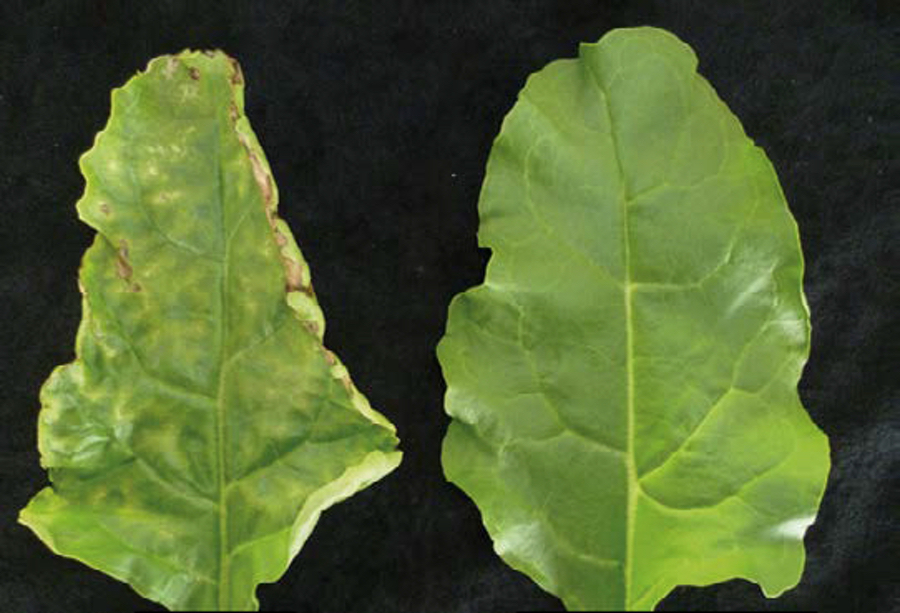
Symptoms of magnesium deficiency on a leaf of sugar beet (left). The leaf on the right has received full nutrient supply (control). (Photo: Tränkner)
Our study clearly showed that an adequate Mg supply significantly enhances photosynthetic CO2 assimilation. Mg is very important for photosynthetic processes, because it is the central atom of chlorophyll and it directly affects Rubisco activity and activation.
Restricted assimilation under Mg deficiency increases oxidative stress because electrons and excitation energy not used in photosynthesis induce excessive production of ROS, i.e., oxidative stress. We quantified that under Mg deficiency this oxidative stress is increased by one third compared to well-supplied plants. The activity of many enzymes and metabolites involved in scavenging of ROS were also found to be increased under Mg deficiency to detoxify ROS.
Critical leaf Mg thresholds for biomass and photosynthetic CO2 assimilation
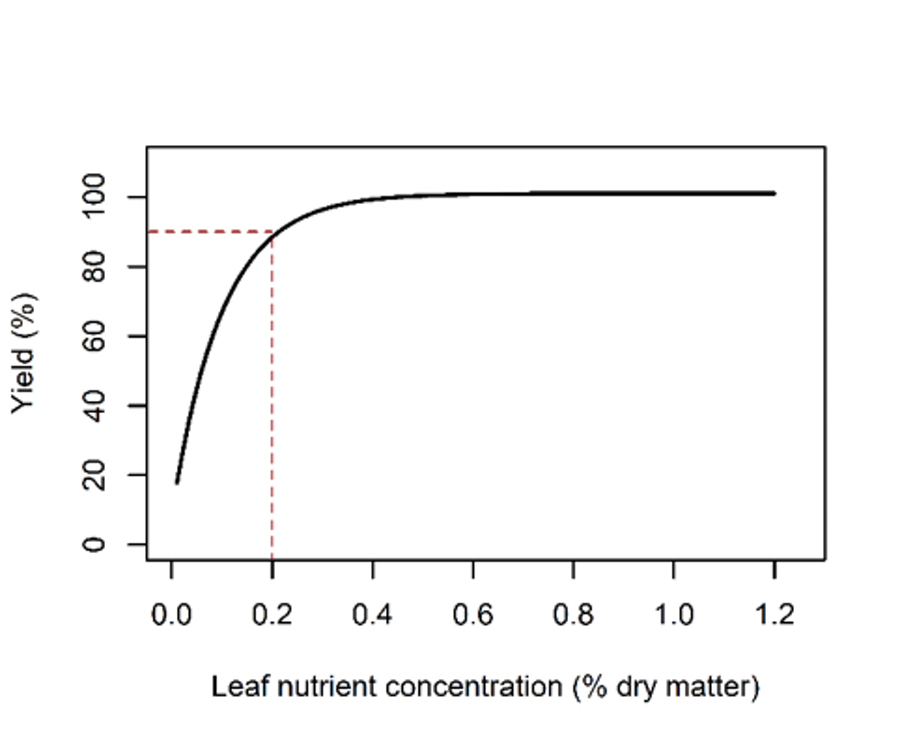
Theoretical relationship between yield and leaf nutrient concentration. The dashed line indicates the critical nutrient concentration producing 90 % of maximum yield. (Source: Hauer-Jákli)
Leaf nutrient concentrations are an important diagnostic tool to determine the nutrient status of plants and therefore to decide about the requirement of fertilizer use. A prerequisite for the concept of critical nutrient concentrations is a specific relation between leaf nutrient concentration and the respective parameter that characterizes growth, such as dry matter, net CO2 assimilation or yield. A critical nutrient concentration is defined as the nutrient concentration at which 10 % loss of the specific growth factor occurs.
For many plant species, these critical values do not exist for Mg or are not up to date, among them major crops such as potato and barley. Studies that relate leaf Mg concentrations to growth parameters of specific species are a possible source of determining critical leaf Mg values in case where those are so far missing.
We combined all available data and calculated the critical leaf Mg concentration for many crop and tree species. We found typical curvilinear relationships between Mg leaf concentrations and dry matter or CO2 assimilation for many species. Most monocots had lower and most legumes higher critical Mg leaf concentrations for dry matter than dicots or non-legumes, respectively. Furthermore, critical values for net CO2 assimilation were higher than for dry matter production for most species.
Our results may help to determine the Mg nutritional status of plants in the field or greenhouse and therefore, to optimize fertilization strategies.
The results of this project were published in mid-2019 in the journal Frontiers in Plant Science.




